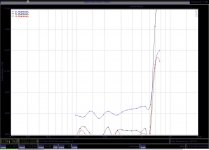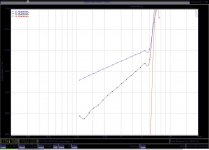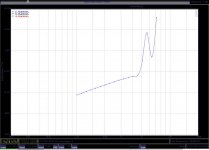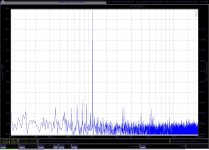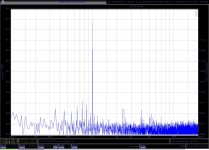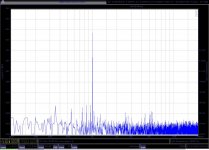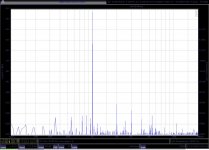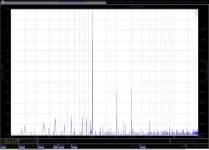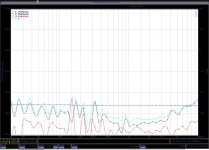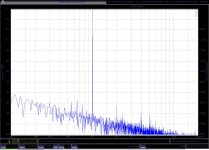i do not want to leave you in the shade so i designed an MPP unbalanced with RIAA for DIY use. i plan to sell stuffed and tested PCB board because the low noise transistors are not easy to get and matching is very critical for best performance. the source impedance to the second stage is a "medium" 340 Ohm so you have a lot of choice for the OP amp. For OP amp 2 (servo) i recommend the OPA134. Other FET types can be substituted. even precision bipolar devices like the LME49710 can be used. For OPA1 i tested AD797, LT1115, LT1028, LT1468, OPA211, OPA827, OPA134, LME49710, NE5534 and others. it´s your choice. I would us the LT1468 here for lowest distortion but i also like the sound of the OPA827 in that position. I found the LT1468 very honest and dynamic, the OPA827 had a bit more character in the way it presented tonality. i like both and differences that seem big after fast swapping disappear quick because both of them play music good enough that i simply forget about the hifi.
P.S. LT1115 (or LT1028 for that matter) is good in that position too because it has resonably low current noise.
P .S. : the first version of the unbalanced phonostage is not valid any more
.S. : the first version of the unbalanced phonostage is not valid any more
(the one with the shunt RIAA) because i think DC offset is simply to high in the inputstage so i use a capacitor now. be not afraid to use it. the cap plus bypass i use is extremely transparent. i would say it gives you 98% of the resolution of a DC coupled design and avoids a servo in the input stage that could create it´s own problem. as i said, the design is good enough to get totally lost in the music.
P.S. LT1115 (or LT1028 for that matter) is good in that position too because it has resonably low current noise.
P
(the one with the shunt RIAA) because i think DC offset is simply to high in the inputstage so i use a capacitor now. be not afraid to use it. the cap plus bypass i use is extremely transparent. i would say it gives you 98% of the resolution of a DC coupled design and avoids a servo in the input stage that could create it´s own problem. as i said, the design is good enough to get totally lost in the music.
Attachments
JG, what I was trying to determine, is whether you had an EXTRA problem with record warps, which you would have if you had too low a tone-arm resonance and if the arm was overdamped. This does not be the case, so I don't see how you could overload your preamp with low frequency warp signal.
and matching is very critical for best performance.
As I stated in the past providing two degrees of freedom via resistor trims can usually trim offset and gain/residual seconds both to zero with parts picked at random out of the bag. I posted a circuit and some scope plots a while back. A simple input/VAS stage could do 5E6 Aol and uV offsets with just about any 2SK170/SJ74's and 4401/4403's
As for the sonic signatures of passives and various op-amps, it is best to just let it be, nothing but trouble.
tonight i had an idea for two varieties of the MPP that are even simpler.... The fet version is slightly noisier and has a high input impedance. noise in the fet version can be reduced by paralleling.
That is getting very close to what I've been working on on/off for a long time now.
Here's my latest incarnation.
An externally hosted image should be here but it was not working when we last tested it.
hi john ! no, subsonic is not a big problem in my system, anyway i will design a subsonic filter that could also help when digital transfer is wanted. my idea is a 6th order bessel at 16 or 18 Hz.
hi scott ! where can i find your posts ? i have added here two circuits that have adjustable gain and offset. one is FET and one is bipolar-transimpedance. i think the bias to the bipolars should change offset and gain in one trim. would you do it that way or do you have a better idea ?
hi werner: yes, that looks much as an even more simple single ended version. should work well too and can not be beaten in simplicity. i can not really understand what is going on in the op amp stage. do you run it on only one supply ? is it a differential stage? where is the second ground connection for? anyway i send you a drawing how i understand it. thanks guys for contributing, i have a lot of fun
hi scott ! where can i find your posts ? i have added here two circuits that have adjustable gain and offset. one is FET and one is bipolar-transimpedance. i think the bias to the bipolars should change offset and gain in one trim. would you do it that way or do you have a better idea ?
hi werner: yes, that looks much as an even more simple single ended version. should work well too and can not be beaten in simplicity. i can not really understand what is going on in the op amp stage. do you run it on only one supply ? is it a differential stage? where is the second ground connection for? anyway i send you a drawing how i understand it. thanks guys for contributing, i have a lot of fun
Attachments
yes scott, this listening tests to passive and active components are time consuming and not very pedictable nor very repeatable but ones you have made your choices it gets much more easy and you have a nice toolbox with building blocks. i work as beta tester for several companies so i do that all the time (actually not, i also listen to music 1 to 2 hours a day just for relaxation. i get payed for that work in the form of free samples. the problem that i see is that single components may not make a big difference (i swear nobody will hear a difference between a AD797 and LT1115 in a blind listening test) but a circuit is build from hundreds of components so these differences albeit small can culminate.
Joachim,
"what is going on in the op amp stage. do you run it on only one supply ? is it a differential stage? where is the second ground connection for?"
Your drawing is correct. The symbol in my schematic is not an opamp, but a differential in / diff. out programmable voltage source with a huge gain. I always use these in simulations as opposed to full opamp models (my simulator is node-limited).
Years ago I started work on a complex Vendetta-inspired phonostage. It would become a two-box affair with big LC-filtered supplies, multiple transformers, a single-ended FET transconductance stage driving an inverting opamp. Getting it DC-stable and with zero offset ended up being more complex that I anticipated, and I dropped the idea for a while.
Recently I revisited it. With the aim of building a much smaller version I accepted the idea of an electrolytic cap in the input of the opamp (partially bypassed with one of the RIAA caps), and a split load on the transconductance output. One half (1k5) to ground, also for DC biasing, and the other half (1k5) through the big capacitor into the opamp.
I found the resulting simplification very appealing.
Now waiting on my just-ordered Eagle license to start the real work.
With two toddlers and an extremely demanding dayjob I have little time for DIY, and soldering must be done in the very rare moments I am home alone. Hence PCBs in favour of breadboards...
"what is going on in the op amp stage. do you run it on only one supply ? is it a differential stage? where is the second ground connection for?"
Your drawing is correct. The symbol in my schematic is not an opamp, but a differential in / diff. out programmable voltage source with a huge gain. I always use these in simulations as opposed to full opamp models (my simulator is node-limited).
Years ago I started work on a complex Vendetta-inspired phonostage. It would become a two-box affair with big LC-filtered supplies, multiple transformers, a single-ended FET transconductance stage driving an inverting opamp. Getting it DC-stable and with zero offset ended up being more complex that I anticipated, and I dropped the idea for a while.
Recently I revisited it. With the aim of building a much smaller version I accepted the idea of an electrolytic cap in the input of the opamp (partially bypassed with one of the RIAA caps), and a split load on the transconductance output. One half (1k5) to ground, also for DC biasing, and the other half (1k5) through the big capacitor into the opamp.
I found the resulting simplification very appealing.
Now waiting on my just-ordered Eagle license to start the real work.
With two toddlers and an extremely demanding dayjob I have little time for DIY, and soldering must be done in the very rare moments I am home alone. Hence PCBs in favour of breadboards...
hi werner ! have you build it and listened to it ?
i would do the elcap with two 220uF back to back ( minus together) from Panasonic FM or Rubicon ZLH with a 0.1uF Röderstein MPP bypass and the sound should be just fine. i even found a maker of expensive Mic amps (Millenia) that claims that elcaps in the signal chain improve sound. strange is´nt it.
hi stinius ! thanks, there is a lot of complexity going on there so i need some time for digesting
i would do the elcap with two 220uF back to back ( minus together) from Panasonic FM or Rubicon ZLH with a 0.1uF Röderstein MPP bypass and the sound should be just fine. i even found a maker of expensive Mic amps (Millenia) that claims that elcaps in the signal chain improve sound. strange is´nt it.
hi stinius ! thanks, there is a lot of complexity going on there so i need some time for digesting
i promissed more overload measurements of the original MPP and here they come. anyway, this is history now that i know that matching and improved current source can make much better distortion readings. again measurement are taken in dB/U RMS one leg swing only. they start at 1V and are compensated for RIAA gain this time.
Attachments
so here come measurements on the new MPP unbalanced. It has good speed and amplification. when i set the gain to 30dB with the 340 Ohm resistor - 3dB bandwidth is 3.5MHz so gain bandwidth is 105 MHz. i will calculate the slew rate later. a 100kHz squarewave is reproduced without overshot and very straight lines. i will show a photo later in this tread too. HF demodulation is virtually non existend partly because the circuit has quite a low input impedance. is this at last an atvantage of the transimpedance topology ? i show distortion measurements at different output voltages. they start at less then 50dB. that amounts to an equivalent input voltage of 0.1mV. i did this measurement to look at resolution problems at low volume. maybe when i find the time i will measure at even lower volume. 0.02mV should be posible. the circuit seems to behave quite monotonic so i am thinking that low level resolution is good. on the plots you can see some intermodulation products. partly they are measurement artifacts (under 1kHz) and partly it is radiation from two nearby toroidal trannies. the circuit seems quite sensitive to hum injection and my lab powersupply is not really good enough. i will work on grounding and shielding and also started to work with Salas on a really good supply. installed at my home hum and noise are not audible in the listening seat at high volume. with the ear close to the speakers i hear a very faint "light" sounding noise and some hum with an unpleasant overtone spectrum. hum is slightly dominating in terms of subjective volume. hum got better when i put the trannies farther away but i could not get them any further because the cables are not long enough. anyway, in the finished version i will put the trannies in a seperate box with pre filtering.
Attachments
i found clipping at -3dB/U so it can put out (head amp section only) 2.5V (P-P).
shown here is a sweep at 50mV (head amp only) and total distortion and noise including following RIAA stage at 1V dB/U RMS also done with my lab PSU. i think distortion is not a problem any more with the new design and i am very pleased that the MPP had such good potential for improvement.
shown here is a sweep at 50mV (head amp only) and total distortion and noise including following RIAA stage at 1V dB/U RMS also done with my lab PSU. i think distortion is not a problem any more with the new design and i am very pleased that the MPP had such good potential for improvement.
Attachments
Having now solved the noise problem i did now 2 longer listening sessions. one was with a modified bladelius MM stage that i know very well for many years and use as a benchmark (when it sounds good with that stage i know nothing is wrong) and one with my own MM stage. I listened to classical, jazz, pop, funk, hip hopp and south american folklore. the classical pieces where Lorin Mazel on Decca with Respigi and a Proffesor Johnson recording of Berlioz. the Berlioz is easy one of the best recordings availlable so most competent equipment makes it sound quite spectacular. i noticed slightly better depth of image and better focus and wider spread of the soundstage than i am used to. that came as a pleadant surprise because depth of image is a little restricted in my new listening room. this is the most serious flaw of my new room compared to the old one that on some records could throw a 20m deep soundstage. the new room is better in other regards. for example the sound can be very high and broad. i think the stage that i can populate is 8m wide, 6m high and 5m deep. on some recordings like the ones that are made in Q sound, the sound can come subjectively from my yard, in my head, around my head and even in the back of my head. that is posible because i sit very close to the widely spaced speakers. and speaker build i can ! that at least my customers tell me and i like them too. the Respigi is much more problematic because it has a very delicate string tone that can easily be destroyed. the MPP did good on the string tone but i have heard it more spectaculary fleshed out with tube equipment. it sounded a tiny little bit synthetic and that may be the way it was recorded. it is a quite late DECCA and i think not recorded with tubes. anyway during the last two days i heard the MPP mature quite nicely and the tone got rounder over time. where is did spectaculary well was on Brass and Percussion : this is a very dynamic phonostage. the music just jumps on you. Brass and Woodwind is pefect food for the MPP. So is vokal. Vokal rendition male ( Donald Fagen ) and female (Nona Hendrix, Mercedes Sossa) is very low in coluration and distortion, tightly focussed right there in front of you. Donald Fagen sounded 10 years younger then he used to on "Gaucho" , some unpleasant nasal tone cleaned up, well his voice is a little nasal but not unpleasant. Nona Hendrix sounded fresh and powerfull and Mercedes Sossa gave me a privat concert in the Argentinian Pampa. Well i could go on and on. Yes i am pleased and whould call the nature of the sound fresh, open, transparent, dynamic, wideband, natural (also spacecial because small things stay small and big thing are really big in terms of perceaved dimensions). I could imagine that flat eathers whould love the sound too because it has tremendous timing precission. i play live and hear a lot of live music so i was pleased to hear good interplay between bass and drum on Galiano "the plot thickens" for example. I could not hear subjective distortion, to the contrary, the sound is subjectively squiky clean. I think the "double-double" mono arangement of the powersuplies have really helped the soundstage, so does the very good low level resolution. This may not be the best choice for listeners that prefer a fat, round, golden tone that makes it´s precence known all the time but it can sound warm and intimate SOME time. it perfectly compliments my Lyra Titan that is also quite alive and kicking. it´s like riding in a Porsche or an AUDI A8 : It´s fast AND safe.
